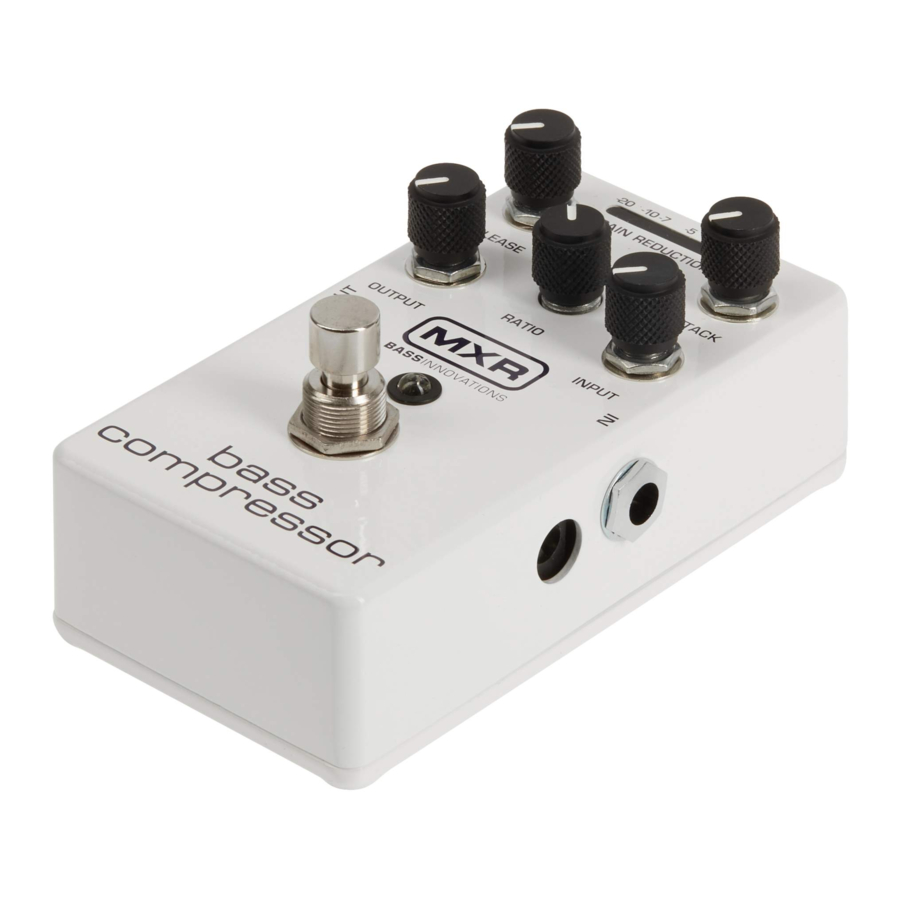
Advertisement

DESCRIPTION
- Classic studio compressor in a Phase 90-sized pedal
- CHT™ Constant Headroom Technology for clear, clean performance
- Ten Gain Reduction status LEDs
- True bypass
POWER
The MXR Bass Compressor is powered by one 9-volt battery (remove bottom plate to install), a 9-volt AC adapter such as the Dunlop ECB003/ECB003E, or a DC Brick ™ power supply.
CONTROLS

- METER display shows gain reduction level and compressor response time
- RELEASE knob controls how quickly your signal returns to its uncompressed gain level
- ATTACK knob controls reaction time of compression
- OUTPUT knob controls overall effect volume
- RATIO sets the degree of compression, from mild 4 (4:1) to extreme 20 (20:1)
- INPUT knob controls gain level of input signal
- FOOTSWITCH toggles effect on/bypass (blue LED indicates on)
DIRECTIONS
- Run a cable from your bass to the Bass Compressor's INPUT jack and run another cable from the Bass Compressor's OUTPUT jack to your amplifier.
- Set RELEASE, ATTACK, OUTPUT and INPUT controls to 12 o'clock and the RATIO control to 4.
- Turn the effect on by depressing the footswitch.
- Observe the METER display while playing normally and set the INPUT knob so that the first 3 to 7 green gain reduction LEDs light, clockwise to light more and counterclockwise to light less LEDs.
- Rotate the OUTPUT knob clock-wise to increase overall effect volume or counterclockwise to decrease it.
- Rotate the ATTACK knob clock-wise to increase reaction time of compression or counterclockwise to decrease it.
- Rotate the RELEASE knob clock-wise to increase the time it takes your signal to return to its uncompressed level or counterclockwise to decrease it.
- Use the RATIO knob to select compression ratio. The 4 setting selects a 4:1 ratio, meaning that if the input level rises 4 decibels above threshold, the output level will only rise by 1 decibel. Therefore, gain has been reduced by 3 decibels. The 8 setting selects an 8:1 compression ratio, 12 selects 12:1, and 20 selects 20:1.
COMPRESSION
Standard studio dynamic range reduction can be achieved by setting ATTACK and RELEASE knobs to 12 o'clock, with a 4:1 or 8:1 ratio, and by adjusting the input control to consistently light the -3 to -7dB LEDs while playing. To soften the sound of your attack, dial in a faster attack time (CW) and reduce the input control (CCW) to light only the -3 to -5 dB LEDs during note attacks. To accentuate the sound of your attack, dial in a slower attack time (CCW) and a faster release time (CW). For a more compressed sound, set the input control to a higher level (CW) to light more gain reduction LEDs with a slow release time and a fast attack time.
LIMITING
Limiting refers to high compression ratios (12:1 or 20:1) with fast attack and release settings. The Bass Compressor's 12 setting produces soft limiting while 20 setting produces hard limiting, and even "brick wall" limiting with the fastest attack and release settings. In contrast, to get the classic 'squishy' limiting effect, dial in a slow release time (CCW) with a fast attack.
METER
Short string taps are an easy way to see the METER display Compressor reaction time and can be helpful in setting Attack and Release controls.
SPECIFICATIONS
| Input Impedance | 1 MΩ |
| Output Impedance | 600 Ω |
| Max Input Level | +14 dBV |
| Max Output Level | +8.5 dBV |
| Freq. Response | ±1 dB, 20 Hz to 20 kHz |
| Noise Floor* | -90 dBV |
| THD** | > 0.5% |
| Gain | 31 dB |
| Compression Ratio | 4:1, 8:1, 12:1, 20:1 |
| Attack Time | 20 µs to 800 µs |
| Release Time | 50 ms to 1.1 s |
| Bypass | True Hardwire |
| Current Draw LEDs OFF | 14 mA |
| LEDs ON | 19 mA |
| Power Supply | 9 volts DC |
*A-Weighted, all controls at mid position
** 20 dB gain reduction, 1.1s release setting, 50 Hz to 20 kHz
DUNLOP MANUFACTURING, INC. P.O. BOX 846 BENICIA, CA 94510 U.S.A.
TEL: 1-707-745-2722
FAX: 1-707-745-2658

Documents / ResourcesDownload manual
Here you can download full pdf version of manual, it may contain additional safety instructions, warranty information, FCC rules, etc.
Advertisement




















Need help?
Do you have a question about the M87 and is the answer not in the manual?
Questions and answers